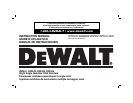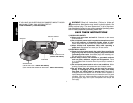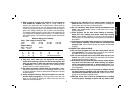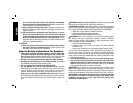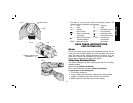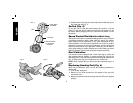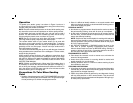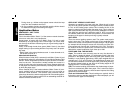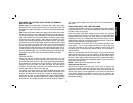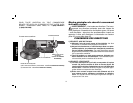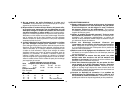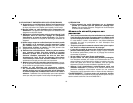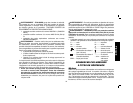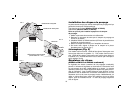
8
English
HOOK AND LOOP AND PSA: WHAT HOLDS THE SANDING
DISK TO THE PAD.
Hook & Loop: The sanding disk as backed with a fabric nap (loops)
that interlocks with a grid of posts (hooks) on the sander’s pad. The
advantages are paper reusability and cooler interface between paper
and work.
PSA: Pressure Sensitive Adhesive is applied to the back of the sand-
ing disc and adheres to the sanding pad (Not the same pad that car-
ries Hook & Loop paper). The advantage is cost. The major disadvan-
tage is the tendency of PSA backed papers to adhere permanently
to the pad if left on after sanding. Why does this happen? The main
culprit is heat. During sanding the pad and paper heat up. This causes
the adhesive to flow into all the ridges on the vinyl pad and form a tight
bond. If you remove the paper soon after you are finished sanding
you don’t allow the adhesive to set. If you leave it on for a couple of
days the adhesive sets and has more strength than the paper carrier,
causing the paper to tear and leaving you with a difficult clean up job.
One more disadvantage: If you do small sanding jobs and don’t wear
out the paper you cannot reuse it and tend to waste more paper.
SANDING
THE BASIC RULES:
Always start with the coarsest grit first. Don’t break this rule. The
scratches get smaller as the grit number gets larger and the quality
of the finish generally improves. When you change grits be particular
about cleaning the surface that you are finishing. An 80 grit particle
floating on your work under your 220 grit paper will leave 80 grit
scratches. The best way to avoid this is to vacuum the work and then
carefully wipe down the work with a tack rag.
The random orbit sander action is equally applied across the grain
and with the grain. Since the scratch mark is small and random in all
directions, the ability of the eye to see a scratch is greatly reduced.
Always wear a mask to avoid breathing the dust. NEVER BREAK
THIS RULE. We have engineered the tool to collect a majority of the
dust created in the sanding process but the tool does not capture it
all. To improve the capture rate use a vacuum but ALWAYS wear a
dust mask.
SOME OTHER HINTS FOR A BETTER FINISH
A random orbit sander is much more aggressive than other similarly
sized orbital tools so you may want to consider the next finer grit when
you start to sand your project.
Since the random orbit action makes a short scratch, you may find
that a project doesn’t require as many grit steps. A lot of professional
cabinet makers only use 80, 120, and 150 grit on their work with
satisfactory results. If in doubt about how the finish will take to your
sanded surface, wipe the surface with some paint thinner. Defects will
show up darker than the surrounding wood.
Careful inspection of the work prior to the finishing operation may
reveal dents. Try to correct these problems by raising the dent
(a hot iron and wet rag will do this) or carefully sand a large area
around the dent. If you vigorously sand the dent, you may create a
cupped surface.
When you are satisfied with the sanding job and you have finished
sanding with your finest grit, raise the grain by dampening the wood
with a wet rag. When the wood has dried and you are ready to apply
the finish, resand lightly to take off the wood fibers raised by the water.
Vac and tack the surfaces and immediately apply the first coat of finish
before the wood gets dirty.
WOOD: Some important characteristics of wood
Hard grain and soft grain
Wood has hard grain and soft grain. Hard grain is typically the
product of summer growth and soft grain the product of spring. All
sanders will remove more soft grain than hard grain and since the
random orbit sander is more aggressive, it will remove it that much
more quickly. Extended sanding on a piece of fir for example, will
produce a noticeably uneven finish. This is a good reason to correct
flaws before sanding.



